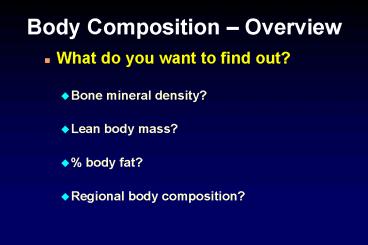Body Composition Overview PowerPoint PPT Presentation
1 / 28
Title: Body Composition Overview
1
Body Composition Overview
- What do you want to find out?
- Bone mineral density?
- Lean body mass?
- body fat?
- Regional body composition?
2
Total Body Density
- If you know the density, you can
determine/estimate composition - Difficulty is volume measurement
- Hydrostatic weighing (measure displaced water)
gold standard - Density mass (weight)/volume
3
Total Body Density Determine fat
- 1 / density fat mass/density fat fat free
mass/ density of fat free tissue - Assume constants density of fat, density fat
free mass and amount of fat free mass (taken from
reference body - Problem The density of fat and fat free tissue
are not constant and can vary widely between
individuals. Also varies with fluid shifts and
other disease states. - Problem The person varies from reference body
only in the amount of fat
4
Total Body Density
- Underwater weighing requires measurement of air
in the lungs at the time of weighing - Theoretical error 2
- Practical error upwards of 10
- No regional/specific information on individual
populations
5
Total Body Water
- Water in two compartments body cells and
extracellular fluids - Dilution of known tracer typically stable
isotopes of water (tritium, deuterium, oxygen-18) - Grams of tracer administered will be diluted and
volume calculated
6
Total Body Water
- Body water w f Cdose / C body water
- W moles of water in original sample
- F fractionation compared to water
- Cdose enrichment or concentration of dose
- Cbody water enrichment or conc in body sample
7
Total Body Water
- Assumptions
- Tracer only in body water the labeled atoms can
undergo exchange with other organics. 2-5
error for all isotopes - Equal distribution of tracer to all compartments
not usually a problem - Fast rate of equilibrium IV takes 2-3 hours.
Oral up to 6 or more - No tracer metabolism constant excretion and
dilution. Plateau method with several
determinations after ingestion
8
Total Body Water
- Fat will not take up water
- Use a hydration constant to determine fat free
mass - Problems encountered must assume the hydration
of fat free mass equal in different individuals
and disease states, measurement error,
instrumentation required
9
Total Body Water fat free mass
- Fat will not take up water
- Use a hydration constant (.73) to determine fat
free mass - Problems encountered must assume the hydration
of fat free mass equal in different individuals
and disease states, measurement error,
instrumentation required
10
Bod Pod
- Naturally occurring radioactive potassium isotope
in the body 40K - Count gamma emissions
- Potssium will be proportional to metabolically
active tissue - FFM - Total body potassium correction 40K counts
- (correction is calibration factor for each
machine)
11
Bod Pod
- Fat free mass conversion factor total body
potassium - Precision is excellent, accuracy dependent upon
size of patient, state of nourishment, hydration - Good over the short term within individuals
12
DEXA (dual energy x-ray absorptiometry)
- Underlying principle xrays are attenuated by
body tissue, each to a different degree depending
on frequency (energy). DEXA uses two beams at
different energies. Ratio can accurately measure
attenuation of each component. - Attenuation constant between individuals. Thus,
each pixel contains information on fat and
lean tissue.
13
DEXA
- Advantages
- Scan the entire body for total fat, lean
mass, and bone density - Area determinations that tell both the fat and
lean mass in a single region of interest - Non-invasive, relatively inexpensive, fast
- Good for absolute measurement and following
changes in an individual
14
DEXA
- Bone mineral density
- Attenuation calibrated to phantoms of known
calcium content - Very precise appr. 1
- Good accuracy 2
15
DEXA BMD Caveats
- Assumed that there is no change in attenuation
with thickness. This is not true over about 20
cm - DEXA MEASURES PERCENT COMPOSITION NOT ABSOLUTE
VALUES - Despite labels, DEXA does not measure true bone
density. It is the attenuation in a particular
surface, there is no depth to the measurement
16
Electrical Impedance
- Water with electrolytes conducts water much
better than fat, bone or air. - Volume of a tissue can be calculated by combined
resistance - Dependent upon changes in volume, geometry,
electrolytes, body temp
17
Electrical Impedance
18
Electrical Impedance
- Basic one frequency model
- Body water stature / resistance
- Stature is calculated based on body weight
- Simple equations with R gt 0.9, CV 3
- One frequency model only fair in reporting total
body water after weight loss
19
Electrical Impedance
20
Electrical Impedance
- Best used for epidemiologic studies
- Choice of predictive equations important
- Influenced by fluid shifts
- Biggest drawback is the need for appropriately
calibrated, cross-validated predictive equations
(sme age, sex, ethnicity, and health)
21
Electrical Impedance
- Newer instruments use multiple frequencies with
increased accuracy and wider capabilities.
22
CT
- Area of interest outlined on the slice (r 0.94
with planimetry on cadavers) - Specific density for each tissue of interest
derived from standards - Allows true volume measurement and thus true
density.
23
CT
- Excellent correlation between body fat mass and
cross-sectional abdominal adipose tissue area - Men r0.92
- Women r0.97
- Nine scans required
- Difficulty is radiation exposure and cost
24
CT vs fat in males
25
CT vs fat in females
26
MRI
- Same principal as CT
- May need as few as 1 to 4 slices at the L4-L5
level (questionable benefit) - Major drawback is cost.
- Considered by some to be reference techniques for
body composition
27
MRI
28
Summary
- Most important decide what you need to know for
your research project. - Be aware of errors in each method and assumptions
- Balance cost, safety and availability

